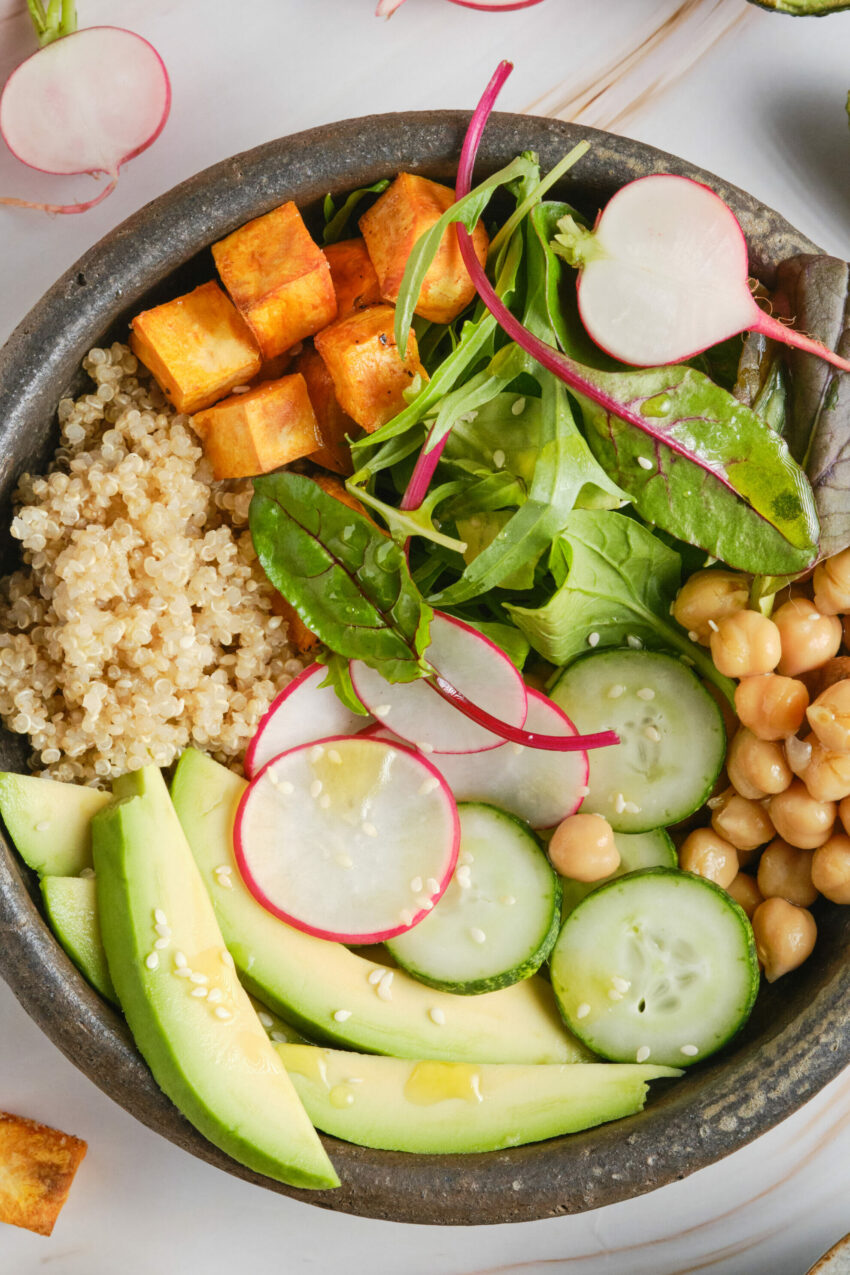Healthy and Delicious Buddha Bowl Recipe

This healthy and delicious Buddha Bowl recipe combines bright vegetables, wholesome grains, and, of course, avocado for a balanced meal that works any day of the week.

Have you noticed how many restaurants serve bowls — collections of nutritious ingredients you just can’t wait to dig into? I wake up every day thankful that I live in such a time. These dishes fill you up and, because of the wide range of ingredients, benefits your body in a variety of ways. Take the Buddha Bowl, for instance — good for your body, good for your mind, good for your soul.
They have also been called nourish bowls, macro bowls, or power bowls… all the names apply, so don’t get caught up in labels. They ARE nourishing, they do provide you with macros, and they do provide you with energy. They are also customizable, which makes going out for Buddha Bowls with friends who have particular eating habits not an issue at all. It also makes having these same friends over for a meal not a problem at all. Take a look at this recipe and you’ll see why.
Why You Will Love This Recipe
- Buddha bowls are a beautiful thing on hot summer days!
- You can customize them with your favorite ingredients and experiment with different proteins to create unique combinations. Explore new flavors, incorporate different spices, and learn how to make your own Buddha bowl with this easy recipe!
- They are easily scalable. Once the individual ingredients have been prepped, you just need to procure an empty bowl and fill it as the diner pleases.
Are Buddha Bowls Healthy?
- Have you been paying attention? Yes, they are! They are packed with so many ingredients (and they are ALL good for you!)
- This particular recipe features a plant-based protein source in the chickpeas.
- Sweet potato contains fiber, as do the chickpeas and the quinoa
- The radishes and lemon juice add vitamin C
- The avocado contains monounsaturated fat, which keeps tabs on LDL (low-density cholesterol), which you will want to keep low.
- Buddha bowls can be customized to suit your dietary needs and can be incorporated into a vegan and gluten-free diet.
INGREDIENTS
There are a lot of ingredients — this is a Buddha Bowl, after all! — but there is no filler, so you’ll want to include all of them.
- 1 small sweet potato, cubed
- 1 tbsp extra virgin olive oil
- 2 red radishes
- 1 cup quinoa
- 2 cups water
- ½ cup canned chickpeas
- 1 cup mixed salad
- 1 small cucumber, sliced
- 1 avocado, sliced
- 1 tsp white sesame, toasted
- lemon juice
- pinch of salt and black pepper

INSTRUCTIONS
Boil
Preheat the oven to 400°F. Line a large baking sheet with parchment paper. Combine the quinoa and water in a medium pot and bring to a boil. Reduce the heat and simmer for 15 minutes until cooked. Remove the pot from the heat and let it sit for 5 minutes.
Roast
Peel the sweet potato and cut into cubes. Toss the sweet potatoes with olive oil, salt, and pepper, and spread onto the baking sheet. Roast for 15 minutes or until golden brown. Remove the roasted sweet potatoes from the oven, set aside, and cool down.
Prep
Thinly slice the radish into rounds and place in ice water for 5 minutes. Cut the avocado in half, remove the stone and the skin, and cut into slices. Toss the avocado slices with a squeeze of lemon. Set aside.
Assemble
Assemble all the ingredients in a bowl. Season with salt and pepper and sprinkle with toasted white sesame. Serve with a sauce or dip of your choice.
DEVOUR!
Variations
Buddha bowls are highly customizable, which is why there are so many variations:
- Vegetables: You can use any cooked or raw vegetables of your choice, like steamed broccoli, shredded carrots, and/or roasted red peppers.
- Protein: We use chickpeas as the main protein source, but feel free to use other proteins like grilled chicken, brown rice, or tofu.
- Toppings: Top your Buddha bowl with anything you like. Some ideas are sliced green onions, hummus, and tzatziki cheese.

FAQs
Yes, of course. Kids love these healthy, colorful bowls filled with grains and vegetables. Get their input with what to include so they feel as though their meal was catered just for them.
Quinoa can easily be replaced with cooked brown rice, farro, barley, or couscous. Cooking times will vary, of course, as will the amount of water required to prepare the new ingredient.
I can’t say there is a “recommended” sauce, which is the nice thing about Buddha bowls — you can use so many different dressings/ingredients and it will taste great. Some to consider, though, are tahini dressing, Greek yogurt and dill sauce, balsamic vinaigrette, or a simple combination of extra virgin olive oil, lemon juice, and a touch of honey.
This recipe is already gluten-free, as quinoa is a gluten-free grain. To make it vegan, choose a vegan-compliant sauce/dressing, like tahini, cashew cream sauce, or a simple vinaigrette. Additionally, ensure that all other ingredients and seasonings are vegan-compliant.
Simply add the seeds to a dry skillet on MEDIUM heat. They should take 3-5 minutes; at which point, they should turn a light golden brown and emit a fragrant aroma.

How to Store Buddha Bowls
In a perfect cooking world, you would be able to disassemble your Buddha Bowl and store the components separately. If you’re dealing with the separate ingredients, here’s how to store them:
- Cooked and cooled quinoa should go in an airtight container and be refrigerated for up to 5 days.
- Roasted sweet potatoes should go in their own container and be refrigerated for up to 5 days. Reheat them in a microwave, oven, or skillet before mixing them with the other ingredients.
- The avocado slices need to be tightly wrapped in plastic. You can also place them in an airtight container with a piece of onion to prevent browning. Consume within 1-2 days.
- Store prepared salad leaves, cucumber slices, and radishes in separate containers or bags, making sure they are dry and clean to avoid wilting and sogginess. Fresh vegetables usually stay crisp for 3-4 days.
- Chickpeas can be stored in an airtight container for up to a week in the refrigerator.
If you’ve already mixed the ingredients together and are wondering what to do with leftovers, I would put it in an airtight container and keep in the fridge for up to 4 days (though the avocado may need tossing).
Some of the bowl’s components can be frozen, provided they are kept separate from the other ingredients. The quinoa can go in airtight containers or resealable bags and then into the freezer for up to 6 months. Thaw before serving. The same goes for the roasted sweet potatoes. The vegetables, however, shouldn’t find their way inside the freezer.


Healthy and Delicious Buddha Bowl Recipe
Ingredients
- 1 small sweet potato cubed
- 1 tbsp extra virgin olive oil
- 2 red radishes
- 1 cup quinoa
- 2 cups water
- ½ cup canned chickpeas
- 1 cup mixed salad
- 1 small cucumber sliced
- 1 avocado sliced
- 1 tsp white sesame toasted
- lemon juice
- pinch salt and black pepper
Instructions
- Preheat the oven to 400°F. Line a large baking sheet with parchment paper. Combine the quinoa and water in a medium pot and bring to a boil. Reduce the heat and simmer for 15 minutes until cooked. Remove the pot from the heat and let it sit for 5 minutes.
- Peel the sweet potato and cut into cubes. Toss the sweet potatoes with olive oil, salt, and pepper, and spread onto the baking sheet. Roast for 15 minutes or until golden brown. Remove the roasted sweet potatoes from the oven, set aside, and cool down.
- Thinly slice the radish into rounds and place in ice water for 5 minutes. Cut the avocado in half, remove the stone and the skin, and cut into slices. Toss the avocado slices with a squeeze of lemon. Set aside.
- Assemble all the ingredients in a bowl. Season with salt and pepper and sprinkle with toasted white sesame. Serve with a sauce or dip of your choice.
Notes
- I can’t say there is a “recommended” sauce, which is the nice thing about Buddha bowls — you can use so many different dressings/ingredients and it will taste great. Some to consider, though, are tahini dressing, Greek yogurt and dill sauce, balsamic vinaigrette, or a simple combination of extra virgin olive oil, lemon juice, and a touch of honey.
- To toast the white sesame seeds, simply add them to a dry skillet on MEDIUM heat. They should take 3-5 minutes; at which point, they should turn a light golden brown and emit a fragrant aroma.
Nutrition
The post Healthy and Delicious Buddha Bowl Recipe appeared first on Food Faith Fitness.


